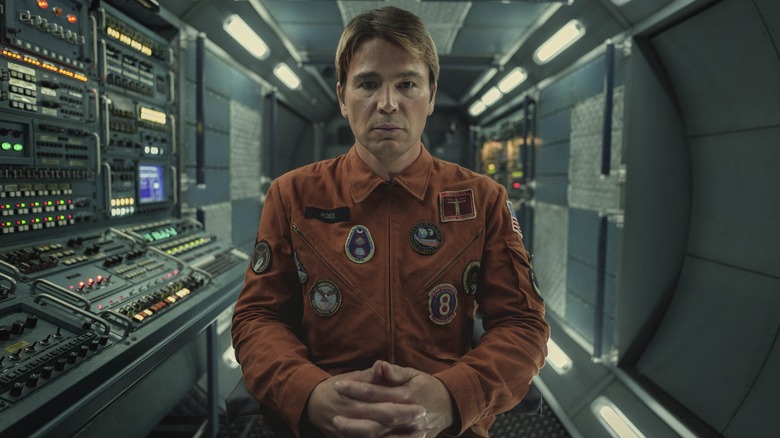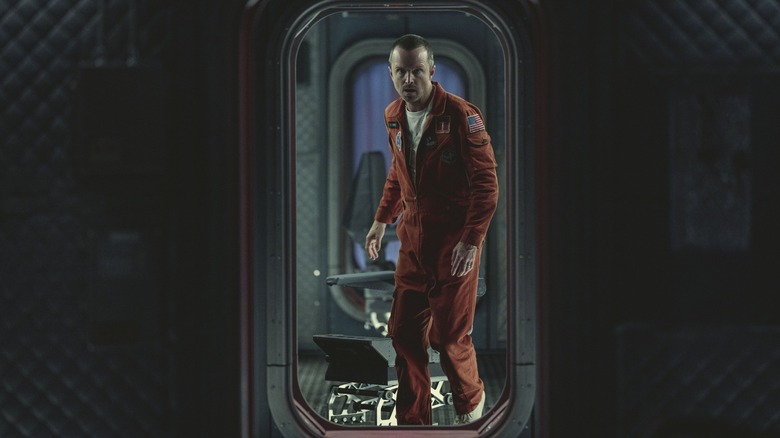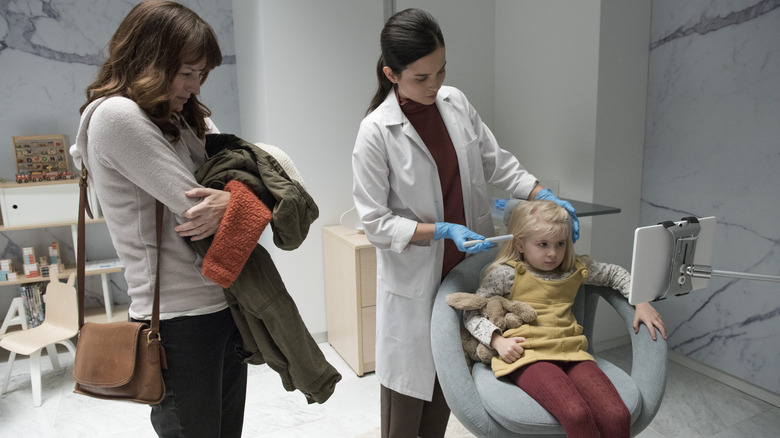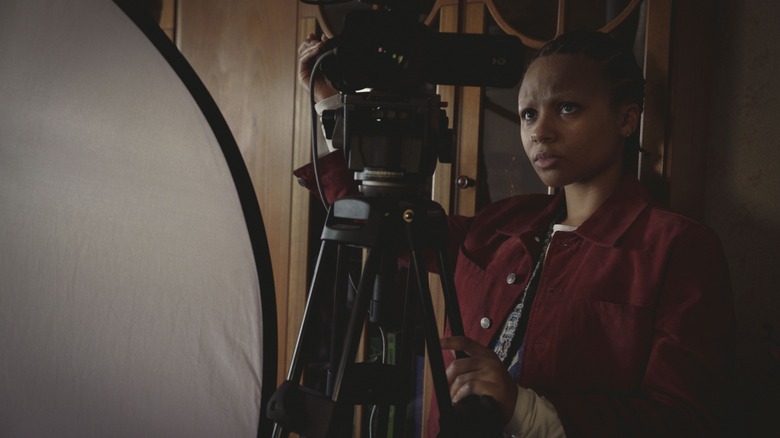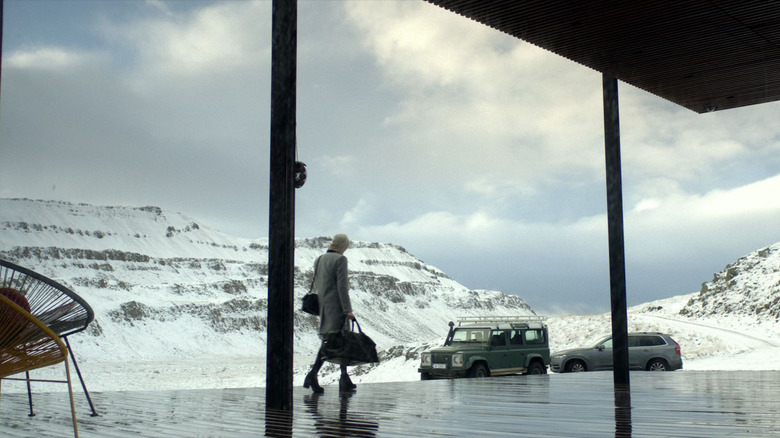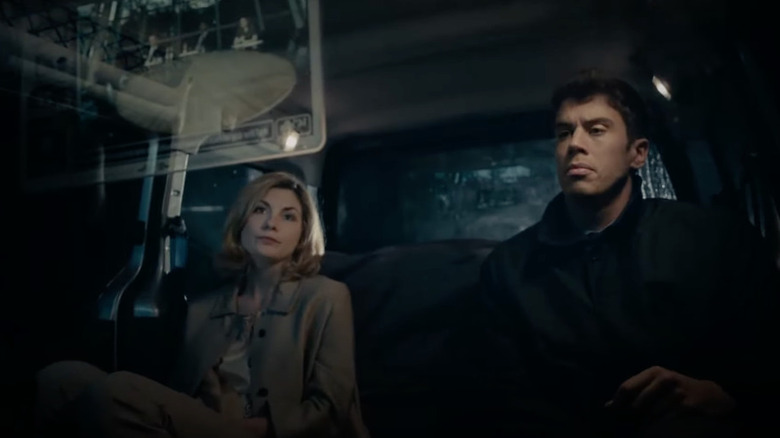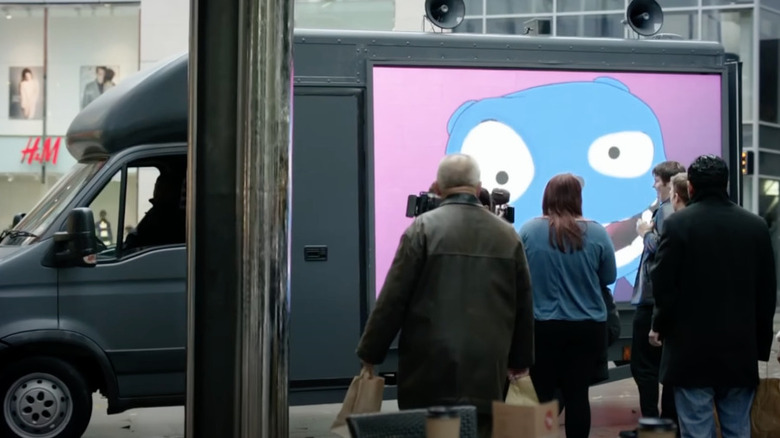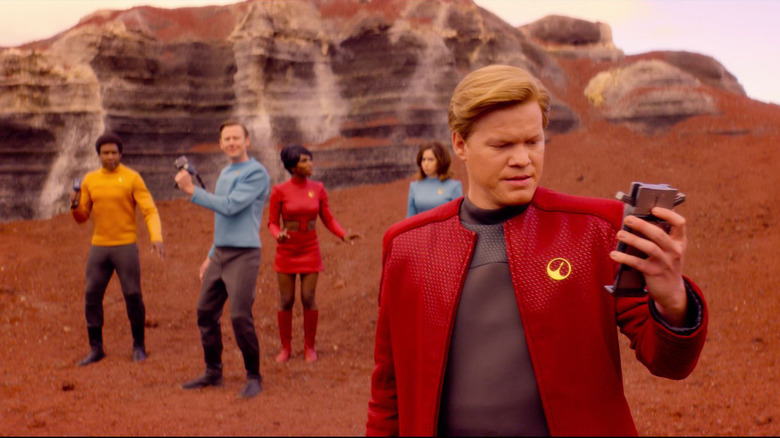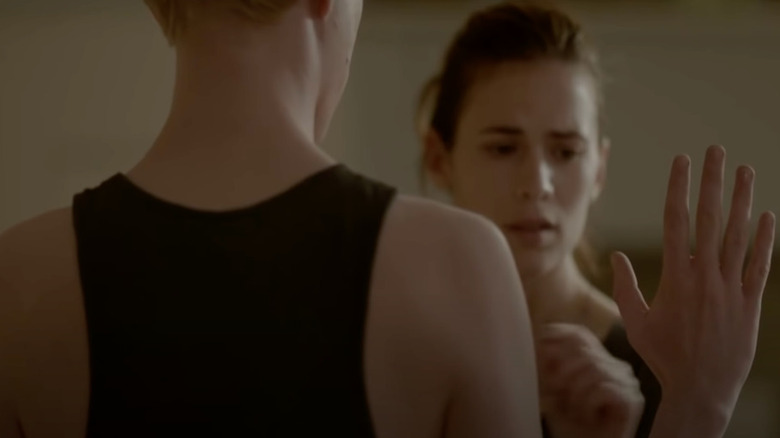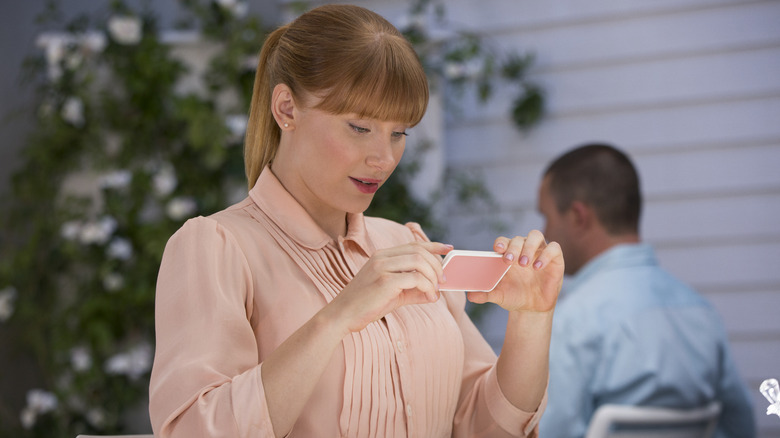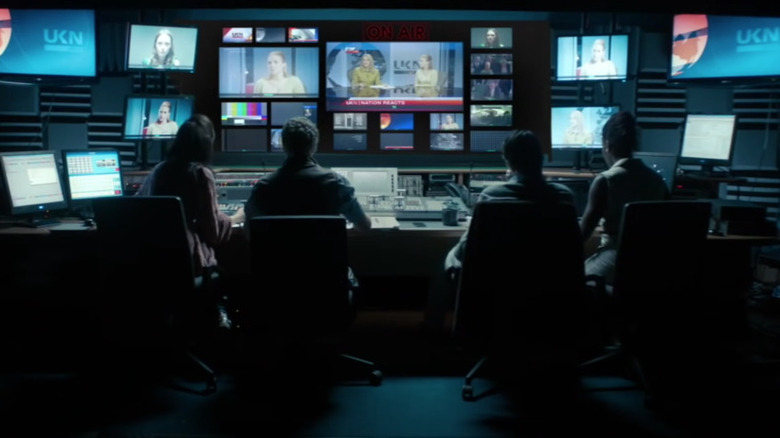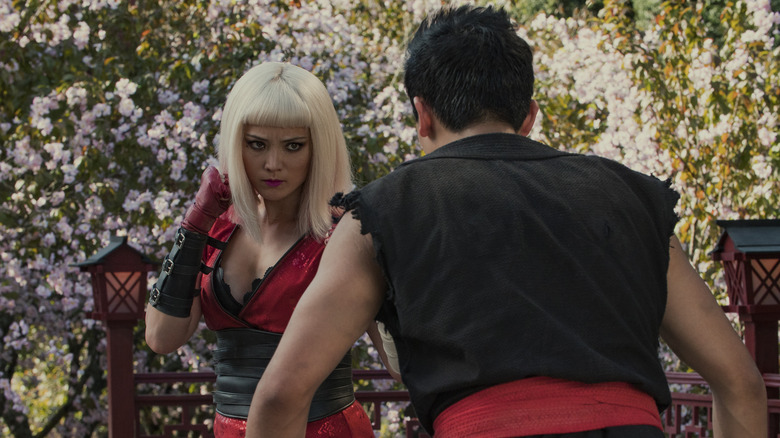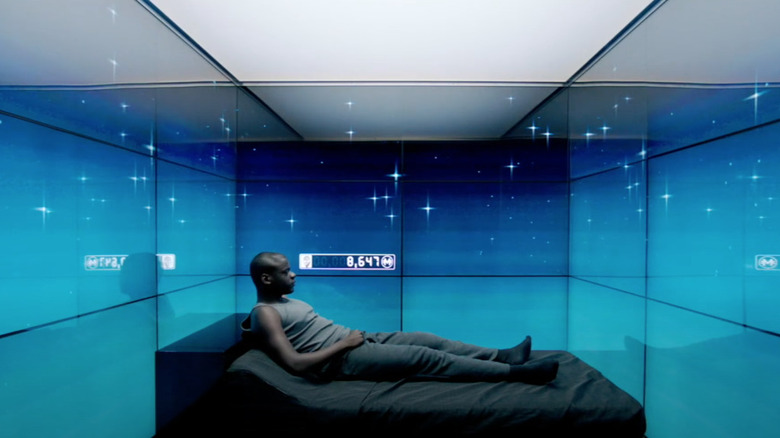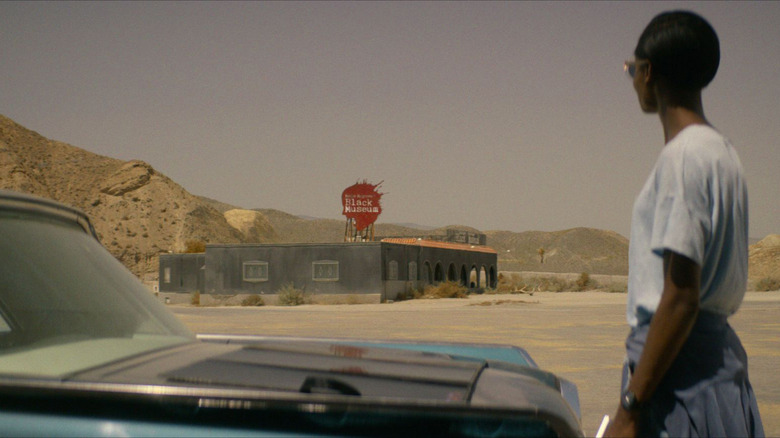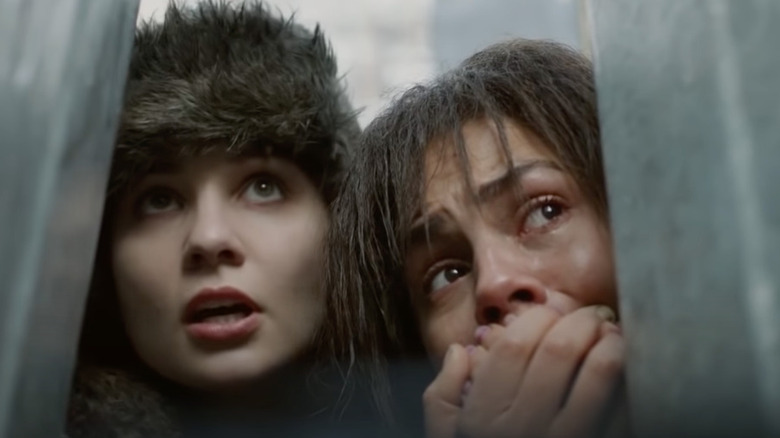The Best Uses Of Actual Black Mirrors In Black Mirror, Ranked
Contains spoilers for "Black Mirror"
If viewers want their nightmares serialized on TV, "Black Mirror" definitely ticks all the boxes. First appearing on Channel 4 back in 2011, the show switched over to Netflix before the start of its third season. The move has caused plenty of derision over the years, with fans still debating what types of episodes are the most successful. Over its six seasons, creator Charlie Brooker has scared viewers silly with a host of fantasy stories that are too grounded in reality to be dismissed. Though Season 6 hasn't proven as popular as the rest, there's no ruling out that "Black Mirror" could return for an even more terrifying seventh season.
Since it first began airing, "Black Mirror" has treated its viewers to plenty of Easter eggs along the way, with some of the more obvious being black mirrors themselves. Though not every episode features the use of a screen, their appearances are always utilized to great effect. From phones that dictate social standing to camcorders that reveal secrets better left hidden in the past, black mirrors are perhaps even more ominous than we first thought. Strap in as we rank the best uses of actual black mirrors in the "Black Mirror" universe.
14. Beyond The Sea (Season 6) — Cliff and David's watches
Though its sixth season hasn't been as well received by fans, the latest outing of "Black Mirror" still gave viewers plenty of Easter eggs in the form of black mirrors themselves. One of the most satisfying examples can be found in the season's third episode, "Beyond The Sea." In an alternate version of 1969, Cliff and David are astronauts who have left their families behind to be stationed on a six-year mission in outer space. While their loved ones are left with robotic replicas of the duo, each is kitted out with a watch that alerts them to certain dangers aboard the ship. In reality, it's code for their real versions waking up, but there's still more to them than meets the eye.
While the watches themselves seem fairly low-tech in the wider world of "Black Mirror," what they actually stand for packs quite a punch. In essence, the watches alert Cliff and David to the wrong kinds of dangers — while they're busy patching things up in outer space, their families back on Earth are at the mercy of Charles Manson-style cults, as well as each other.
13. Arkangel (Season 4) — Marie's iPad
Season 4 marked the start of A-list actors getting involved behind the "Black Mirror" camera as well as in front of it, with Jodie Foster stepping in to direct the season's second episode, "Arkangel." When Marie loses her three-year-old daughter Sara, she decides to install a system that tracks Sara's vision, hearing, and health. By the time Sara is 15, the system is being used against her, with Marie's snooping effectively alienating her through one breach of boundaries after another. It's all being controlled from Marie's iPad — a tool that doesn't leave her side for the better part of 12 years.
In the end, it's Marie's iPad that does the damage to her own physical well-being. Not only is the concept of controlling your child's body through a household item a particularly chilling thought, but the iPad is what Sara uses to beat Marie to a pulp before escaping their house. Some might say that Marie deserved what was coming to her, with some viewers listing the narrative of "Arkangel" as one of the most underrated episodes in "Black Mirror" history. Whether fans agree with Marie's actions or not, her iPad is a fantastic visual marker for her personal progression throughout the episode.
12. Loch Henry (Season 6) — Pia's camcorder
As one of the more terrifying episodes featured in Season 6 of "Black Mirror," "Loch Henry" takes the show back to its gritty British roots. The story follows Davis and his girlfriend Pia as they visit Davis's mother Janet at her home in rural Scotland. Looking to film a documentary about a local man of interest, Pia learns that Davis's hometown holds the secret of serial killer Iain Adair, who used to live there. When the pair agrees to switch their focus to filming what is known about the murders, Pia stumbles on findings that change Davis's life for good.
Though it seems a fairly small part of "Loch Henry," Pia's mid-2000s camcorder that she uses to film Adair's lair is actually the only lens of truth throughout the episode. As its screen turns to blank static once the tape reaches its end, Pia locates forgotten footage that reveals Davis's parents to be the ones orchestrating the torture and deaths. It's a turning point that alters Davis's life and ends Janet's, with Pia's moment of solo discovery a haunting scene to watch. Without the camera, this episode of "Black Mirror" wouldn't have had its gutsy twist.
11. Crocodile (Season 4) — the self-driving pizza truck
Though it wasn't a key part of the main storyline in "Crocodile," the self-driving pizza truck is one of the best examples of a black mirror in the series. The episode focuses on Mia, who is caught up in the killings of two people — one she saw being committed, and one she carried out herself. When insurance investigator Shazia comes to visit her, Mia is subjected to a "recaller" that reveals people's memories and outs her as a killer. Tying Shazia up, Mia leaves to make her family the next target. In the middle of all of this, Shazia's recaller reveals a local pizza truck that has been earmarked during an incident near the murder. It might not seem like a typical black mirror, but it sports a screen for customers to collect their orders.
Despite the pizza truck not doing damage directly to Mia, it set a precedent for technology that was about to seep into real life. Shortly after the episode aired, international chain Pizza Hut announced that it was going to be trialing a similar idea, partnering with Toyota to bring freshly cooked meals straight to people's doors. Given the fact that the "Black Mirror" version had maimed a passer-by, it didn't seem like the smartest idea — with viewers quickly pointing this out. Needless to say, there's probably a good reason we've never seen many out on the roads.
10. The Entire History of You (Season 1) — Liam and Ffion's TV
The classic TV drama doesn't shy away from a secretive love triangle — and the hook of the Season 1 episode "The Entire History of You" is exactly that. Liam and Ffion have the perfect marriage from the outside, complete with a fancy house and a tiny baby. When the couple attends a dinner party with one of Ffion's old flames, doubts begin to emerge in Liam's head. Because this is "Black Mirror," each of them helpfully has a chip implanted in them, giving them the ability to rewatch their memories on TV. As a result, Ffion's affair with the other man comes out, causing Liam to spiral.
Sitting in front of their TV waiting for their memories to start playing is a haunting and heart-stopping moment in this episode. Though nothing is fully revealed at this stage, it's the make-or-break element of their relationship that sends their future in an entirely different direction. Because they have such vivid information at their fingertips, Liam and Ffion turn on each other, becoming spiteful and vindictive as the episode draws to a close. It might be quite difficult to forget you have something implanted right behind your ear, but Ffion's surprise at being caught out is poignant nonetheless.
9. The Waldo Moment (Season 2) — Waldo's billboard
The world would arguably be a better place if we could all create animated characters that drive past politicians on a digital billboard to taunt them. This is the exact premise of the Season 2 episode "The Waldo Moment," which follows failed comedian Jamie who voices the fictitious Waldo, becoming embroiled in the country's annual political race. Waldo proves so popular with the public that TV executives ask him to run for office, but Jamie decides to step away when things take a turn for the worse. Amazingly, the animated bear does end up standing for election, with Jamie watching the events unfold from a nearby hospital bed.
If nothing else, this is a use of a black mirror at its most cathartic. Not only is the image of Waldo presented on one of the biggest black mirrors the show has ever used (his mobile billboard), but the journey to making him sentient requires plenty of smaller ones behind the facade. Starting out as a novelty, Waldo charts the progression from a publicity stunt into murkier politics, eventually goading voters to physically harm his rivals for a monetary bribe. The episode itself continues to be divisive, with some viewers suggesting that the story might hit too close to home.
8. USS Callister (Season 4) — Daly's front door
Mixing retro gamer vibes with the typically "Black Mirror" terrifying tech, the Season 4 episode "USS Callister" is a top five episode for many fans — yet some feel that it's one of the more misunderstood storylines in the show's history. Robert is a little-recognized genius who has created a multiplayer game called Infinity and made his own version to enjoy privately. When new programmer Nanette starts to give him grief at work, he engineers a version of her into his game to show her the scope of his power. Wanting to escape, Nanette hatches a plan that puts Robert's real self in danger.
While the game itself is the key narrative tool, Robert's front door interface tells us a lot about his Jekyll and Hyde personality. When takeout is ordered to his apartment, Robert is reluctant to interact with the delivery guy, leaving him to stare at a blank screen in total confusion. It's the starkest representation of the callous plans Robert has bubbling under the surface, with his absence from social interactions in the real world allowing him to continue the facade of being a regular guy.
7. Be Right Back (Season 2) — Martha's laptop
"Black Mirror" has often dabbled with mixing the perils of technology and matters of the heart, and the opening Season 2 episode "Be Right Back" might be the most emotional example of this. After Martha's boyfriend Ash is killed while trying to return a hire van, she is stuck alone in their brand-new house in the countryside. She soon learns that she is pregnant and agrees to test a service that her friend has signed her up for, which takes Ash's digital data and transfers it into an AI version. The two must learn to communicate all over again, leading Martha to become frustrated and rethink her earlier choices.
Every decision Martha makes — and therefore everything that happens in her immediate future — stems from the power her laptop screen holds. When she feels lost, it provides her with answers and options, while also being her only point of contact as she becomes increasingly shut off from the real world. While scouring her laptop is the action that maintains her quality of life, it's also the reason that it's all taken away, deeply affecting her daughter's life in the years to come.
6. Nosedive (Season 3) — Lacie's phone
The first of the "Black Mirror" episodes to feature a Hollywood star in a main role, "Nosedive" marked the debut amalgamation of U.K. and U.S. influence. Bryce Dallas Howard's performance has been frequently praised by viewers, alongside the realism of the story itself. Lacie wants nothing more than to be liked, with society's new star rating system dictating her every move. After agreeing to be maid of honor at a childhood friend's wedding — who is now a highly-rated influencer — Lacie's plan to boost her own rating quickly unravels. When she's sent to prison for pulling a knife on the wedding guests, Lacie begins to find freedom away from her digital self.
Out of the actual black mirrors that appear in "Black Mirror," this one might be the most obvious. It's constantly seen in Lacie's hand, taking on a pastel pink color to try and make cruelly rating each other more appealing. The more she vicariously lives through the screen, the unhappier she gets, and it takes something extremely drastic to jolt her out of it. After all, what's a better analogy for 2020s society than that?
5. The National Anthem (Season 1) — No. 10's TV
Back when "Black Mirror" first started out, nobody knew what to expect. However, the show quickly laid down a gauntlet for how far it was willing to go in its pilot episode, "The National Anthem." The story follows the U.K.'s fictional Prime Minister Michael Callow (Rory Kinnear), who is at the center of a blackmail scandal after the kidnapping of Princess Susannah. The kidnappers ultimately want Michael to have sex with a pig on live TV, leaving the public hanging on every word of the unfolding news broadcasts. When Michael agrees to go forward with the plan, it's revealed that the kidnapper had already released Susannah before any decision was reached.
Unlike political dramas like "The West Wing" or "Veep," there's an extra sense of darker tension while the cabinet watches their boardroom TV. Michael essentially has his livelihood and well-being on the line in front of the entire nation, unable to do anything but look at the screen in horror. This is then flipped onto the public when the act is later broadcast, stunned into amazement that it's actually happening. Although his action is made with the safety of others in mind, its reprehensible nature is not easily forgotten.
4. Striking Vipers (Season 5) — Danny and Karl's VR sets
Miley Cyrus and Ashley Too might have taken the bulk of attention in Season 5, but viewers appreciated the steaminess that was packed into the episode "Striking Vipers." Old college friends Danny and Karl reconnect through their shared love of an online VR game after meeting back up at Danny's surprise birthday party. While playing one night, the two engage in a sexual relationship, able to feel every physical sensation that their characters can. Danny then cuts off his arrangement with Karl, leading to a physical fight that gets them arrested.
While the act of adultery isn't condoned, it's refreshing to see two men exploring a rich emotional relationship together. Being blinded from the real world by their VR sets allows them to do this, but also gives the episode leverage to highlight the unconventional relationship dynamics that "Striking Vipers" leaves in its wake. It's the tool that brings old wounds back to the surface, with many viewers in agreement that Danny's wife Theo deserved to be treated better. It's certainly the most immersive black mirror that the show features, with the pair's connection leaving them unable to distinguish between fantasy and real life.
3. \Fifteen Million Merits (Season 1) — Bing's Bedroom
The first instance of "Black Mirror" staring the future of technology in the face was the Season 1 episode "Fifteen Million Merits." It's an episode that instantly leaves an impression, with fans still debating theories on what the story actually means. In a futuristic living environment with a strict class system, Bing spends his days riding a stationary bike to accrue merits. After meeting the talented Abi, he convinces her to apply for a renowned talent show, though her stardom comes with strings attached. Fed up with society, Bing stages a protest on the same show, earning his freedom and own notoriety.
In this world, Bing's entire bedroom becomes the black mirror. Sustaining little human interaction throughout the day, Bing is mostly left alone in his room, faced with whatever is playing on the screens around him. As he loses more merits, he becomes unable to skip the compulsory adverts, learning that Abi has been picked up by the society's porn ring. It's also the first instance t viewers see a black mirror being defaced, with Bing breaking a screen in his anguish.
2. Black Museum (Season 4) — the souvenir keychain
Not every episode of "Black Mirror" sticks to one main storyline, with Season 4's closing episode "Black Museum" becoming an anthology rather than a singular journey. While on a road trip, Nish stops in a sketchy-looking museum that claims to hold artifacts that have rarely been seen. Taken on a tour by the museum's owner Rolo, Nish learns the backstory of three items, each stemming from a particularly twisted narrative. As the episode draws to a close, viewers learn that Nish has a personal connection to the museum's main attraction and has made a detour to get it shut down.
Arguably, the attraction itself counts as multiple black mirrors, but the museum's use of a souvenir keychain is skin-crawlingly haunting. Guests are allowed to electrocute a hologram of Nish's dad, with his reaction to each shock immortalized in the keychain. It's a sobering visual, but one Nish turns on its head by rigging the system up to electrocute Rolo instead. She leaves having put her dad's digital self at peace — and certainly has the best prize of all to show for it. Viewers cite "Black Museum" as one of the best episodes of all time, one that keeps fans guessing until the very end.
1. White Bear (Season 2) — Victoria's TV
Let's face it, all "Black Mirror" episodes are scary — but the terror was turned up a notch in the Season 2 episode "White Bear." Victoria wakes up in her house with no memory of what happened the day before, soon finding that people on the street record her without speaking to her. Desperate to find out what's going on, she meets Jem, who explains that the area is affected by an unknown signal. Being attacked by hunters while trying to destroy the signal transmitter, Victoria learns that the entire ordeal has been staged as punishment for being an accomplice to a child murderer. She actually lives in White Bear Park, where she must relive the same events for tourists every day.
In short, it's bone-chilling stuff. In the opening few minutes of "White Bear," Victoria is presented with a strange symbol on TV that has no meaning, only occasionally glitching as she tries to work things out. The symbol tells viewers exactly what's happening before they've even pieced it together, with it later following Victoria throughout her day. There's a great deal of power in what Victoria sees on her screen, making her believe that she should be remembering something that she doesn't. It tantalizes fans with the biggest clue they need to stay hooked, yet never offers any further explanation. Overall, it's a stroke of genius.
